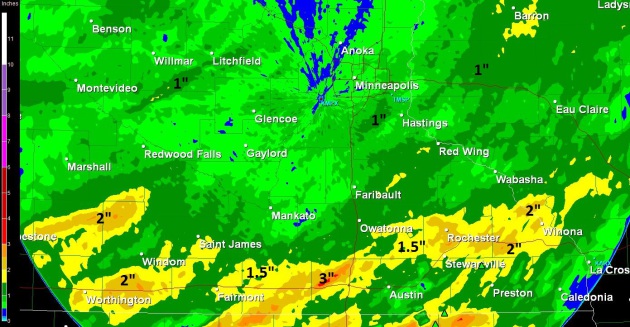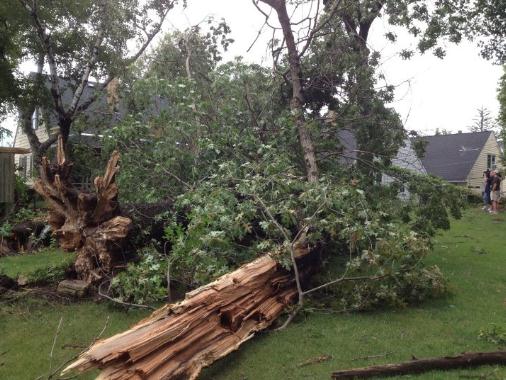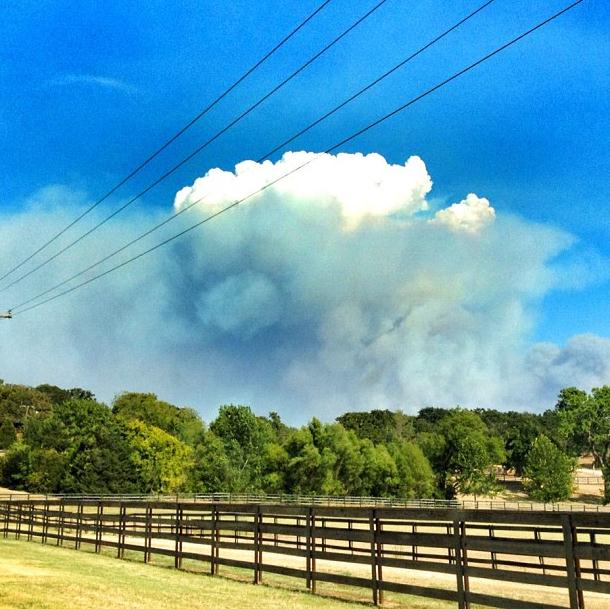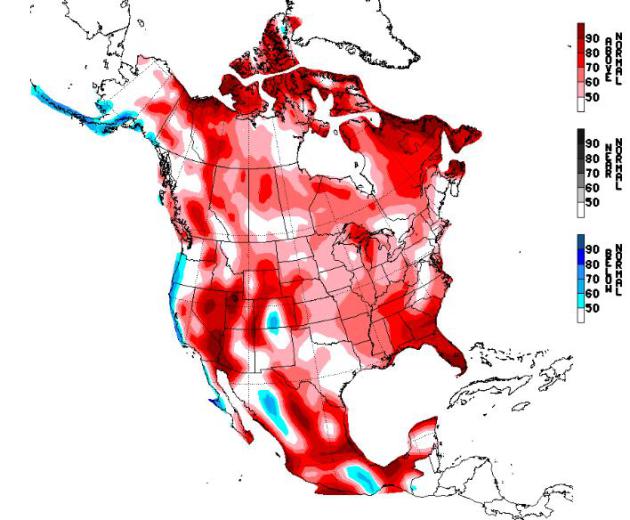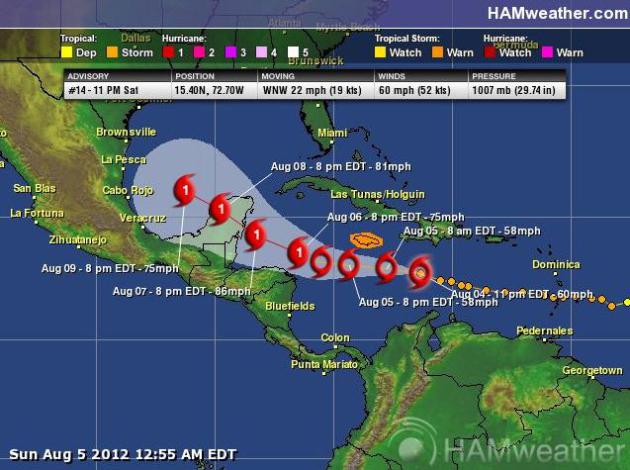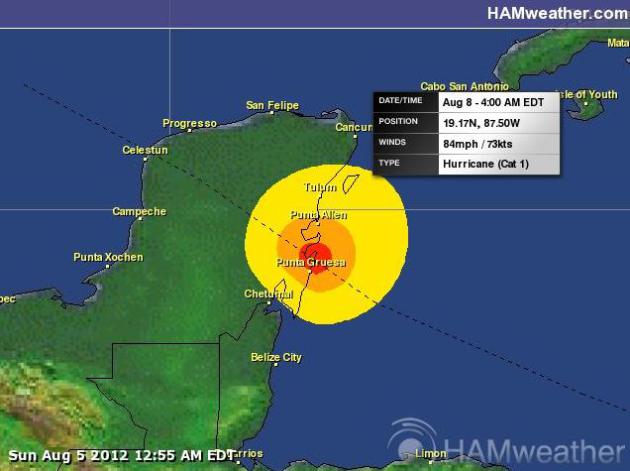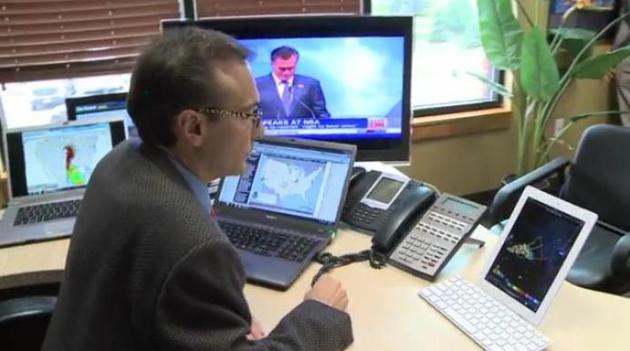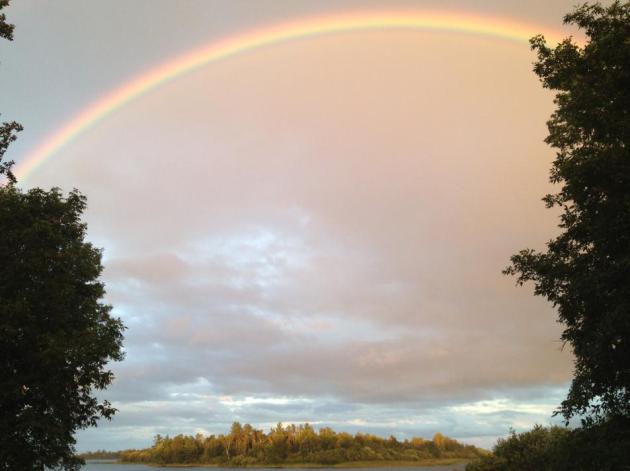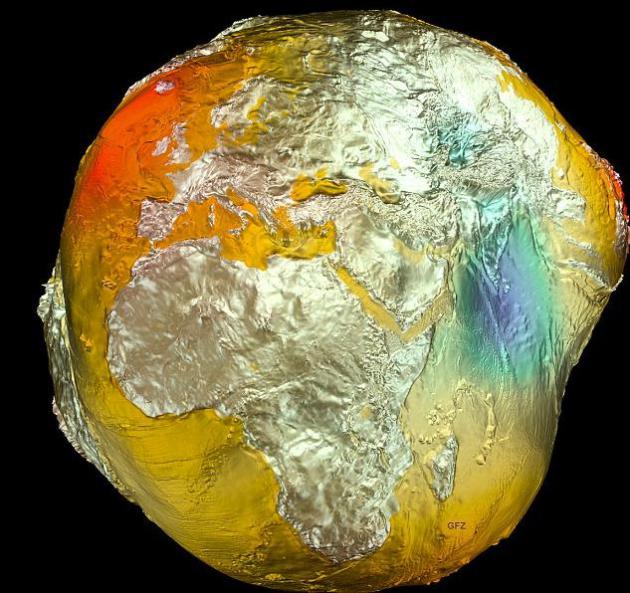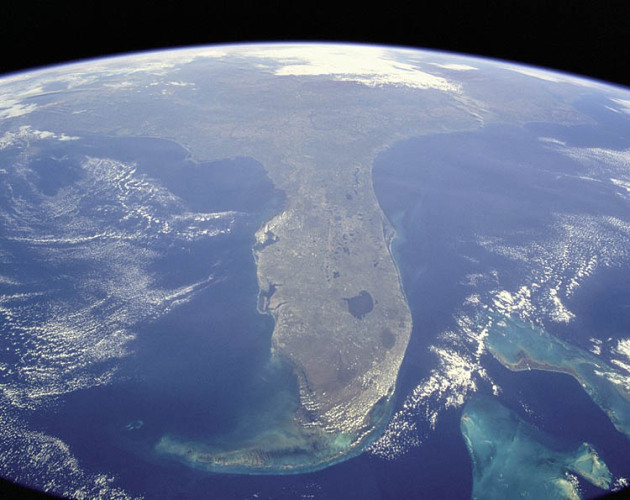Hurricane Ernesto? Tropical Storm Ernesto is
expected to strengthen into a Category 1 hurricane, landing a direct hit
on Mexico's Yucatan Peninsula. More details below.
Sunday PM Weather Map. High pressure settling across
the Midwest and Central Plains will insure comfortable sunshine, while
the leading edge of this (much) cooler, Canadian air sparks strong to
severe storms from the Ohio Valley into the Mid Atlantic states. WRF
model valid at 4 pm above courtesy of NOAA.
Severe Sunday. SPC is predicting another severe
storm outbreak from New England to D.C. - west to Louisville and Little
Rock, along the leading edge of Canadian relief.
Comfortable Sunday - Summer Returns Tomorrow. The
model ensemble is in good agreement; mid to upper 70s today give way to
highs near 90 tomorrow, a few of the NAM models are hinting at mid 90s
tomorrow afternoon. Overall this week will not be as blazing-hot as
recent weeks.
A Warm, Relatively Quiet Week. No, it's too early to
write off summer heat, although I don't see any protracted run of
extreme heat into early next week. Our warm bias continues over the next
7-10 days, a late-week cool front sparking the best chance of T-storms
late Wednesday into Thursday, followed by a brief, downward blip in
temperature by Friday. ECMWF model output above.
Multi-Million-Dollar Soaker For Far Southern Minnesota.
Even though we're well past the tassling phase for corn farmers -
Friday night's soaking rain was a welcome sight. NWS Doppler radar
rainfall estimates range from 1" south metro to as much as 3" near
Albert Lea, a huge swatch of 1-2.5" amounts along the I-90 corridor.
Serious Tree Damage. Thanks to KARE-11 for passing
on this photo of some of the tree damage in the Red Wing area, reports
of numerous 100-year old trees knocked over by Friday night's severe
storms - winds estimated at 70 mph.
NOAA Drought Outlook. This isn't the weekly Drought
Monitor, but rather a prediction of where drought is expected to expand
or contract. The worst drought since 1956 is forecast to push into North
Dakota and eastern Montana (as well as much of Texas), but some
improvement is likely over the southeast and Arizona, courtesy of a
persistent "monsoon" flow of moisture. NOAA's latest Drought Outlook is
here.
Hot Weather Factoids:
110+ F. weather for three straight days at Oklahoma
City? This is only the second time in recorded history this has happened
- the last year: 1936. Stat: #OKwx.
Saturday was the 4th straight day above 110 F. at OKC - most ever. #OKwx.
24 days at or above 95 F. in Washington D.C. Most to date on record.
Saturday: 39th straight day of 80+ highs in the Twin Cities, second longest 80+ stretch on record.
24 days of 90+ at Denver as of Saturday, tying the longest streak on record.
32 days so far in 2012 with 90+ highs at Cincinnati. 30-year average is 21 days/year.
* thanks to WeatherNation meteorologist D.J. Kayser for tracking down these (remarkable) numbers.
A Tale Of Two Summers. Moisture trends above average
this week east of the Mississippi, with some 2-4" rainfall amounts
predicted by NOAA HPC for the southeastern states, relatively dry
weather for the western half of the USA.
Dozens Of Homes Destroyed In Oklahoma Wildfires. A withering drought is producing ripe conditions for major fires -
NBC News has the story (and video): "
At
least 121 structures, many of them homes, have been destroyed by
wildfires in Oklahoma, officials said Saturday as temperatures topped
100 degrees for a 19th straight day. New evacuations were under way
Saturday as well: Included were the entire towns of Glencoe, population
of around 600, and Mannford, population about 3,000, and surrounding
areas. Thousands were on the move as a fire spread quickly in Creek
County, 20 miles west of Tulsa, the Oklahoma Highway Patrol
reported. Gusty winds were expected in the area on Saturday evening."
Pyrocumulus. Here's a spectacular example of
"pyrocumulus", updrafts from wildfires providing enough lift for cumulus
formation over Slagherville, Oklahoma. Pic courtesy of
@southshorechick.
Don't Write Summer Off Just Yet. You may need a
light jacket or sweatshirt this morning, and there's little doubt our
weather is transitioning into more of a "progressive" pattern, meaning
more frequent changes, with intrusions of cooler Canadian air coming
with slightly greater frequency and intensity. The heat-pump high
pressure bubble that has been nearly stationary over the Central Plains
and Ohio Valley since late June is weakening, and migrating westward,
allowing the flood gates to open up, pushing cooler fronts farther
south, from the Upper Midwest into New England. That could also mean
more frequent rains for the Corn Belt, but over the Plains the damage
has already been done; wilted crops are past the point of no return,
many farmers plowing under their (stunted) crops. The map above shows
NOAA's "
NAEFS" long-range model for August 12-18.
Latest On Ernesto. Packing 60 mph. sustained winds,
Ernesto is a moderate to strong tropical storm. In spite of weak wind
shear aloft conditions are ripe for additional strengthening - Ernesto
forecast to hit near Punta Grueasa, Mexico on Wednesday, packing winds
of 84 mph. The brunt of the storm is forecast to pass south of Cancun
and Cozumel. NHC models bring Hurricane Ernesto into the southern Gulf
of Mexico later this week, a possible threat to far southern Texas by
late week. Maps above courtesy of
NHC and Ham Weather.
Threat Of Hurricanes Looms Over RNC Convention. No, it couldn't possibly happen, right? The odds are small, but not zero, as reported by
Fox News Latino; here's an excerpt: "
The
Republican National Convention is scheduled for late August, prime time
in the Atlantic's dicey hurricane season. Though planners are banking
on years of data that a major storm won't hit, they also have laid out
worse-case scenarios that include canceling if it's clear the 70,000
expected delegates, officials, journalists and protesters would be in
harm's way. Tampa is one of the places in the region most vulnerable to
storm surge. In a major hurricane, floodwaters could reach some 3 miles
inland — Tampa is on a bay, not directly on the Gulf of Mexico — and
storm surge could reach as much as 17 feet. The Tampa Bay Times Forum,
the convention's home, is in an area that would be required to evacuate
if winds exceeded 96 mph."
"Ask Paul" Weather-related Q&A:
"
What was the winter like in the Twin Cities after that hot summer in 1988?"
Thanks Paul,
Ginger Knaff, West St. Paul, MN

Ginger - it's tempting to go back in time to a similar
(blazing) summer for clues about what we can expect this upcoming
winter. After 44 days at or above 90 during the steamy summer of 1988,
we had an old fashioned fall and winter in the Twin Cities; 15.8" snow
in November - a total of 70.1" for the entire winter. It would be (too)
simplistic to say we're in for a tough winter this time around. One big
mitigating factor: El Nino. NOAA is predicting an El Nino
winter, which correlates with milder winters for Minnesota (with less
snow overall). One thing I've learned the hard way: don't buck the
trends. We've had 14 months/row of warmer than average temperatures, and
if I had to gamble and make a long-range (winter) prediction I'd go
with a continuation of milder than normal, with more sporadic snowfall
(based on El Nino). Lately it seems maybe 1 in 4 or 1 in 5 winters is an
old-fashioned (butt-kicking) winter with bitter temperatures and
excessive snowfall. Personally, I hope we see more than the meager 22"
that fell last winter, but I'm not (yet) convinced we're going to see a
70" snowfall this winter. Somewhere between 23" and 70" would be my
guestimate. How's that for vague?
* 3 month outlook from NOAA's CPC (
Climate Prediction Center) shows a lingering warm bias east of the Rockies from August through October. Beyond that, place your bets. Good luck.
Dog Days of August. That's our 1 year old spaniel, Leo, helping me in the kayak - his first time out on the water.
Calendar Angst
"I try to take one day at a time, but sometimes
several days attack me at once" lamented Jennifer Yane. I can relate.
August makes me want to hyperventilate. 3 more weeks to jam in frantic
trips to the cabin, frenzied fishing attempts and ill-fated projects in
the yard. I love every season - but Minnesota summers are
extra-precious.
Back to school sales, football tickets, State Fair spots on the tube? How did this happen?
The Great Drought of '12 deepens over America's
heartland, but at least we're seeing some rain. Friday night's
window-rattling storms unloaded a cool 1-3" rain on much of southern
Minnesota; a multi-million dollar rain for farmers.
This morning was a subtle (yet blunt) reminder
that the sun is as high in the sky as it was in early May. We've lost 65
minutes of daylight since June 20.
Sorry.
Searing heat shifts into the western U.S this
week.; more aggressive puffs of Canadian air east of the Mississippi. No
hair-curling heat, but 90 F. may return as early as tomorrow, but this
week won't be nearly as hot as recent weeks.
Today? A well-time preview of September: 70s - dew points in the 40s. Perfect.
T-storms may return by late Wednesday, as residents of the Gulf Coast keep a watchful eye on "Ernesto".
* photo above courtesy of Heidi Rusch, who snapped this photo after a late afternoon shower up at Breezy Point yesterday.
Climate Stories...
Study By "Global Warming Godfather": Texas Drought, Europe Heatwaves Are Climate Change.
Some breaking news from NASA's James Hansen, one of the first
scientists to raise awareness of global temperature trends in the
mid-80s, courtesy of
The Washington Post: "
The
relentless, weather-gone-crazy type of heat that has blistered the
United States and other parts of the world in recent years is so rare
that it can’t be anything but man-made global warming, says a new
statistical analysis from a top government scientist. The research by a
man often called the “godfather of global warming” says that the
likelihood of such temperatures occurring from the 1950s through the
1980s was rarer than 1 in 300. Now, the odds are closer to 1 in 10,
according to the study by NASA scientist James Hansen. He says that
statistically what’s happening is not random or normal, but pure and
simple climate change."
Photo credit: AP
Climate Change Is Here - And Worse Than We Thought. James Hansen attempts to connect the climate and (extreme) weather dots in this excerpt of a
Washington Post Op-Ed: "...
To
the contrary, our analysis shows that, for the extreme hot weather of
the recent past, there is virtually no explanation other than climate
change. The deadly European heat wave of 2003, the fiery Russian heat wave of 2010 and catastrophic droughts in Texas and Oklahoma
last year can each be attributed to climate change. And once the data
are gathered in a few weeks’ time, it’s likely that the same will be
true for the extremely hot summer
the United States is suffering through right now. These weather events
are not simply an example of what climate change could bring. They are
caused by climate change. The odds that natural variability created
these extremes are minuscule, vanishingly small. To count on those odds
would be like quitting your job and playing the lottery every morning
to pay the bills." (Image above: NASA).
Presidential Contenders Can't Duck Climate Change - But They Are. An excerpt from
current.com: "
How
much more proof do we need? Few scientists doubt that Earth's climate
is changing and growing warmer. Only a small number of skeptics dispute
that humans are a prime cause of the problem. But still, as a nation,
we dither. The United States is among the world's top three emitters of
carbon dioxide and other greenhouse gases, along with China and India.
And yet our so-called leaders continue to tiptoe around the issue as if
they might wake a sleeping baby. At least some people are awakening.
They've slept late, but they're awakening nonetheless."
Study Shows Planet Keeping Pace With CO2 Emissions.
The big question: when will the oceans be unable to soak up some of the
excess CO2 floating overhead? Great question. Here's a snippet from
Climate Central: "
Climate
change is a serious enough problem, but it could be a lot worse. About
half of the carbon dioxide we’ve pumped into the atmosphere by burning
fossil fuels has been absorbed by plants and oceans, rather than
staying in circulation to drive up temperatures. Scientists are
convinced this can’t go on forever — but a new study in Nature
shows that we haven’t come to the danger point yet. Over the past 50
years, says the report, humans have quadrupled our emissions, but the
planet has kept up by doubling the amount of CO2 it absorbed. That comes
as something as a surprise: several earlier, small-scale studies have
suggested we might be on the verge of a tipping point where the planet
can’t absorb any more carbon dioxide. “So we decided to take a step
back and ask, ‘do we see this at a global scale?’” said Ashley Ballantyne of the University of Colorado and lead author of the new report, in an interview, “and the answer is no.”
Climate Science Still Trumps Skeptics. Good for Climate Central's Michael Lemonick for debunking many of the regurgitated claims of skeptics in this
L.A. Times article; here's an excerpt: "...
Also
quite predictably, several of the comments repeated critiques of
mainstream climate science that have been raised and thoroughly
debunked literally hundreds of times. Here’s a sampling, along with my
responses:
"theblooms" writes: "Anthropogenic Global Warming is FAR FROM
PROVEN. If the evidence is so damn clear-cut, then why did the East
Anglia University Climate Research Unit cook the books and falsify the
data?"
Response: The East Anglia researchers didn’t
cook the books. Any suggestions otherwise are based on taking fragments
of emails completely out of context. Several investigations have
cleared these researchers of any scientific misconduct whatsoever. The
were reprimanded only for failing to respond with enough thoroughness
to a barrage of freedom-of-information requests from climate skeptics."
The Great Ice Meltdown And Rising Seas - Lessons For Tomorrow. Here's an excerpt of an interesting paper from
NASA:
"As accumulating atmospheric greenhouse gases lead to further climate
warming, sea level rise will accelerate, endangering coastal communities
by more frequent flooding, exacerbated beach erosion, and saltwater
penetration into streams and aquifers. Twentieth century global sea
level rise has averaged 1.7 mm/yr, increasing to around 3 mm/yr since
1993, as measured by TOPEX/Poseidon and Jason satellite altimetry.
Current trends exceed those of the last few millennia by 1 to 2 mm/yr, based on saltmarsh data from many localities."
Graphic credit above: "
Generalized sea level rise since
the last ice age showing several meltwater pulses (MWP). MWP-1A0, c.
19,600-18,800 years ago; MWP-1A, 14,600 to 13,800 years ago; MWP-1B,
11,000-8,800 years ago; and MWP-1C, ~8,200-7,600 years ago."
Climate Change Is Real - Just Ask My Cows. Here's an excerpt of an Op-Ed from
coshoctontribune.com: "...
In
our part of the country, rain has tended in recent years to come in
great spring and fall floods -- six-to 12-inch deluges bookending
hotter, drier summers. Pretty much nobody whose livelihood depends upon
the weather denies it: The climate hereabouts is changing, mostly for
the worse. The underlying fear, of course, is that the scientists are
right: that what we're experiencing is the knife-edge of worldwide
global warming. People don't much talk about that aspect of it, because
the whole thing's gotten bound up with politics, and rural people tend
to avoid issues with ideological and theological overtones. Farm
Bureau and Cattleman's Association publications tend to be filled with
strident climate change denial, and regional newspapers with
predictable right-wing boilerplate."





